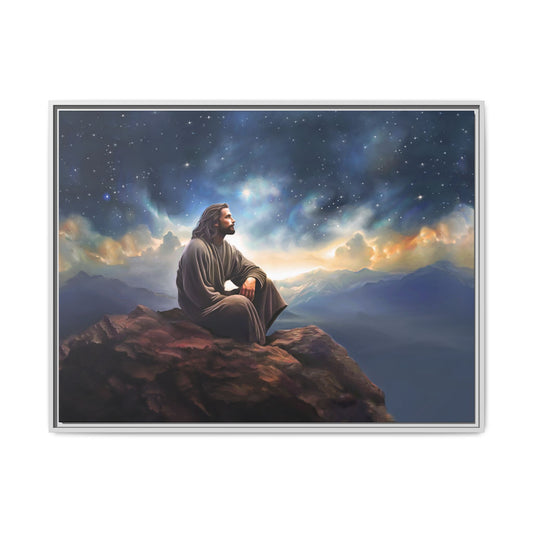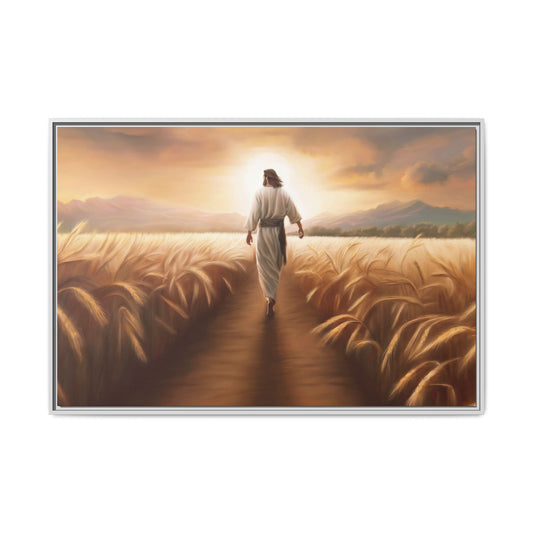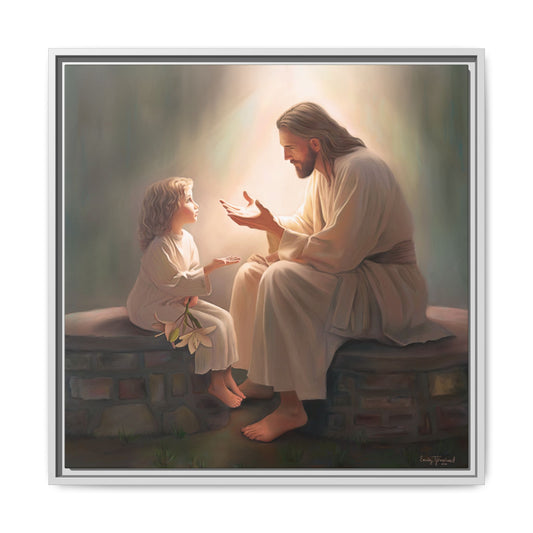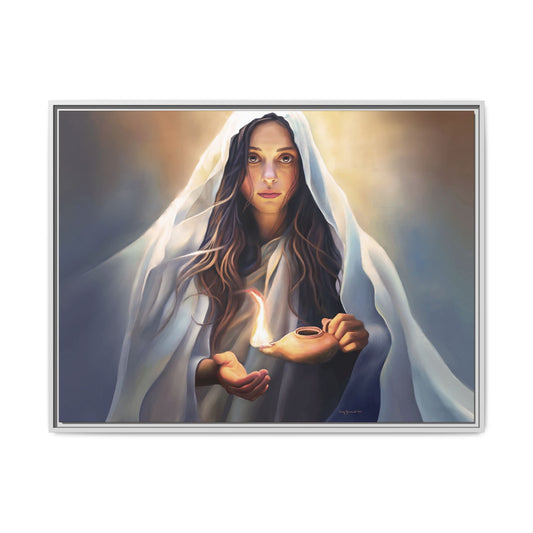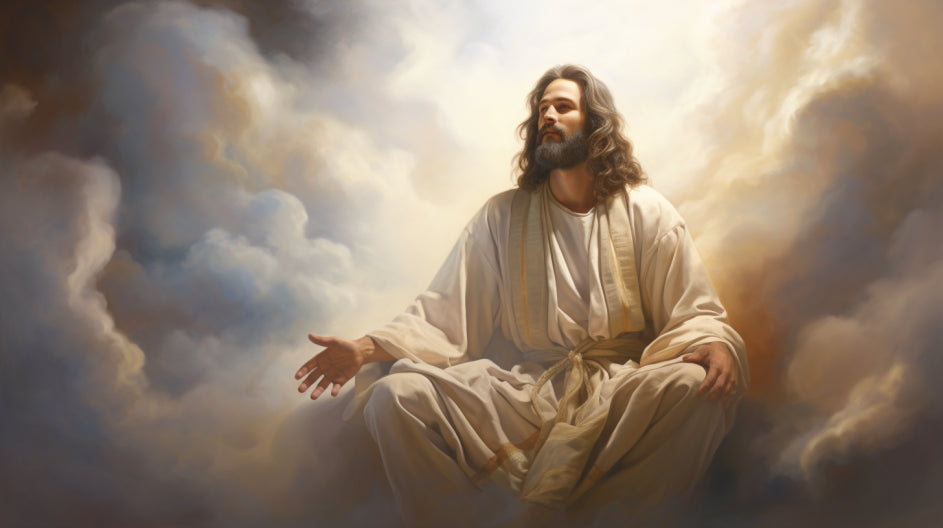
A Picture of God
Share
You might not realize it, but your mind's eye has been searching for a form to attribute to the divine, and 'A Picture of God' offers an innovative lens through which to explore this quest.
This isn't your typical theological tone; it's a cutting-edge visual narrative that looks into how artists have dared to depict the indescribable.
'A Picture of God' isn't just about viewing representations; it's about seeing through them to question, connect, and reflect on the nature of the divine in our lives.
Key Takeaways
- 'A Picture of God' explores the quest to depict the divine, challenging preconceptions.
- Jesus portraits serve as focal points for devotion and reflection, which can add to the worship experience.
- Art in Christian worship plays a role in communicating and internalizing theological concepts.
- Jesus portraits throughout history reflect societal shifts and theological discourse, shaping collective religious imagery and individual faith experiences.

A Picture of God
We find Jesus portraits frequently in places of worship, where they serve not merely as art, but as focal points for devotion and reflection.
This article aims to examine the significance these visual representations might play in shaping worshipers' perceptions and experiences of the divine.
The significance of Jesus Portraits in worship
Within the context of worship, portraits of Jesus can serve as a profound visual anchor for faith, providing a tangible focus to represent our devotion. In the quest to conceptualize "A Picture of God," we turn to scriptures for descriptions and metaphors that capture the divine nature and essence of God. These passages provide a foundation for artistic representations that seek to embody God's attributes rather than an attempt to depict a physical likeness:
Exodus 3:14: 'God said to Moses, "I AM WHO I AM. This is what you are to say to the Israelites: 'I AM has sent me to you.'" This declaration to Moses from the burning bush reveals God as the eternal, self-existent being, inspiring art that emphasizes the timeless and unfathomable nature of God.
Psalms 19:1: 'The heavens declare the glory of God; the skies proclaim the work of his hands.' The majesty of creation serves as a testament to the creator, guiding artists to represent God through the beauty, complexity, and grandeur of the natural world.
John 4:24: 'God is spirit, and his worshipers must worship in the Spirit and in truth.' This verse emphasizes the spiritual nature of God, inspiring representations that focus on the transcendence, purity, and omnipresence of God, rather than attempting to depict a physical form.
1 John 4:8: 'Whoever does not love does not know God, because God is love.' The essence of God as love encourages artists to explore themes of divine love, grace, and compassion, portraying God through actions and effects rather than physical characteristics.
Alma 26:12 (Book of Mormon): 'Yea, I know that I am nothing; as to my strength I am weak; therefore I will not boast of myself, but I will boast of my God, for in his strength I can do all things.' This expression of faith and humility before God’s greatness can inspire artwork that depicts the empowering, uplifting nature of God's presence in the lives of the faithful.
Doctrine and Covenants 19:23: 'Learn of me, and listen to my words; walk in the meekness of my Spirit, and you shall have peace in me.' Here, God invites us to learn from Him and find peace through His Spirit, suggesting representations of God as a source of guidance, peace, and wisdom.
Moses 1:39 (Pearl of Great Price): '"For behold, this is my work and my glory—to bring to pass the immortality and eternal life of man."' This scripture illuminates God's purpose and mission, offering a perspective for art that reflects God’s overarching desire for the eternal progression and joy of His children.
In creating "A Picture of God," artists and believers alike are encouraged to explore beyond the confines of physical depiction, seeking instead to capture the profound attributes, actions, and presence of the divine. These scriptures serve as a guide, offering diverse lenses through which God's essence can be envisioned and expressed, allowing for a deeper connection and understanding of the divine through artistic interpretation.
As we engage in worship, these representations can foster a connection to the divine, echoing the comfort and power symbolized by His presence.
Consequently, the demand for such sacred depictions reflects their integral role in personal and communal expressions of faith.
In exploring 'A Picture of God', we'll uncover some profound ways in which artists can influence our perception of the divine through their visual interpretations. This article serves to:
- Explore some diverse visual representations of God and Jesus.
- Examine how these images can have an impact on individual spirituality and collective belief systems.
- Offer insights into the creative uses of heavenly pictures for personal and spiritual enrichment.
The purpose of this article is to explore the intersection of art, faith, and perception. By examining various depictions, we can gain a deeper appreciation for the artistic endeavors that strive to give form to the formless and comprehend the incomprehensible aspects of God.
The Power of Visual Representation
Art plays a role in Christian worship, often serving as a conduit for the faithful to experience the divine in their own projections and reflections of the art.
Visual aids can serve as a stepping stone toward experiencing the divine; they offer an invitation through which complex theological concepts are communicated and internalized. And still, our spiritual relationship with God is always a step beyond that stepping stone.

The Role of Art in Christian Worship
Art can serve as a conduit for spiritual expression, which can enable a deeper connection with the divine in Christian worship. The integration of art into worship isn't just about aesthetics; it's an invitation to inquire about the psychological and emotional aspects of our faith.

The impact of visual aids on spiritual experiences
Often, visual aids like paintings or photographs enhance our spiritual encounters by exploring the story from a new angle that words alone can't fully express. Sometimes pictures and art can push us out of our familiar knowing-ness about something. There is a great potential impact of an image to invite us to reflect on the divine in ways we may not have previously considered.
Whether it's a depiction of Jesus or a symbolic representation of broader spiritual themes, these visual aids can deepen our understanding and emotional engagement with the spiritual realm. Artist portrayals of spiritual themes have a capacity to evoke feelings and provoke thoughts that resonate on a deeply personal level.
Jesus Portraits Throughout History
We have all encountered depictions of Jesus that span centuries, each portrait embodying the historical and cultural contexts of its time. Consider how the evolution of these representations reflects societal shifts and theological discourse.
Examine iconic works, noting their role in shaping the collective religious imagery and individual faith experiences.
As we examine the evolution of Jesus' portrayal in art, we see various historical contexts that have moved and shaped these iconic images over centuries. The historical background informs the portrayal of Jesus, with each epoch contributing distinct aesthetics and symbolic elements.
- Early Christian art often utilized symbolic forms rather than literal representations, focusing on Jesus' divine nature.
- The Middle Ages brought more humanized depictions, emphasizing Jesus' suffering and humanity.
- The Renaissance era celebrated divine and human beauty in art, leading to some of the most renowned images of Jesus Christ.
This analytical examination of Jesus' portrayal in art sets the stage for a deeper exploration into the evolution of Jesus portraits and their cultural influences.
Evolution of Jesus Portraits and their cultural influences
The Jesus Christ image has transitioned from symbolic early Christian art to the more anthropomorphic representations of the Renaissance. This change reflects not just artistic innovation but the shifting theological and cultural landscapes.
Powerful images of Jesus, replete with emotional resonance, emerged, adapting to the sensibilities and values of different epochs. These portrayals have ranged from the ethereal and serene to the visceral and humanized, offering beautiful pictures of Jesus Christ that resonate with diverse audiences.
Acknowledging this evolution of Jesus portraits enhances our understanding of religious iconography's dynamic nature.
Iconic Jesus Portraits that have shaped religious imagery
Through the ages, iconic portraits of Jesus have profoundly influenced religious imagery, having an influence on our perception of the divine. These Christ pictures offer a conduit for theological expression and contemplation.
- Leonardo da Vinci's 'The Last Supper', captures the pivotal moment of betrayal with emotional intensity and narrative depth.
- Michelangelo's 'Pietà', reflects the profound sorrow and humanity of Christ, inviting empathy and veneration.
- Warner Sallman's 'Head of Christ', is an emblematic picture of Jesus Christ that has become one of the most replicated religious images of the 20th century.
These works hint at the innovation and enduring influence of religious art.
Different Types of Jesus Portraits
We encounter traditional depictions of Jesus in religious art that often reflect the norms and artistic conventions of their time.
In contrast, modern interpretations and contemporary styles present Jesus in ways that challenge historical imagery, potentially reshaping spiritual narratives.
The significance of these diverse portraits lies in their capacity to promote inclusivity within the fabric of Christian iconography.
Traditional portrayals of Jesus in religious art
In the world of religious art, many artists have depicted Jesus in a variety of portraits, each aiming to capture a unique aspect of His divinity and humanity. Traditional portrayals of Jesus often reflect cultural and theological perspectives, shaping the image of Jesus Christ in the collective mind.
Consider these varied depictions:
- The Creation of Adam by Michelangelo, where Jesus is a powerful figure of creation and intellect.
- Comforting renditions, such as the resurrected Christ ascending, evoke hope and spiritual solace.
- Emotional captures, with pictures of Christ laughing, present a relatable and joyous Savior.
These images serve to inspire, challenge, and deepen the faith of believers, demonstrating the profound influence Jesus holds within religious art.
Modern interpretations and contemporary styles
While traditional portrayals of Jesus have laid the foundation for religious art, modern interpretations bring a fresh perspective with contemporary styles that can be strikingly diverse. These modern interpretations often aim to resonate with today's audiences, reflecting current artistic trends, social issues, and perspectives.
Contemporary styles challenge and expand the conventional picture of Jesus, offering a myriad of photos of Christ that might more broadly cater to a global audience.
Consider the following:
- Cultural Representation: Diverse depictions allow various ethnic groups to identify more closely with Jesus, fostering a sense of belonging within the faith.
- Theological Diversity: Different portraits can emphasize varied aspects of Jesus' nature and mission, appealing to a broader range of spiritual interpretations.
-
Accessibility: Inclusivity is about making connections; art that represents Jesus in multiple forms makes Him more accessible to people from all walks of life, thereby enriching the collective spiritual dialogue.

Theological Considerations in Jesus Portraits
There are profound theological implications that arise from the portrayal of Jesus in visual art.
Addressing idolatry concerns, it's vital to scrutinize how images are used within the context of worship and the potential for them to distract from the essence of faith.
Considering the wide interpretive range of Jesus portraits, it's beneficial to ponder how these images shape our understanding of His teachings and their transformative influence on our lives. The theological implications of such visual representations are multifaceted:
- They serve as attempted embodiments of abstract spiritual truths, potentially enriching our conception of God.
- They can reflect and even subtly alter the perceived image of Jesus, influencing contemporary worship and devotion.
- These depictions can affect our spiritual reaching by encouraging us to reflect and ponder on heavenly things.
Studying these visual representations can benefit from a nuanced understanding of how art intersects with theology. They aren't just mere illustrations; they embody complex religious narratives and theological ideas, inviting us to seek anew our approach to faith.
The Concern of Idolatry and the Use of Images in Worship
While exploring the myriad of Jesus portraits, it's important to note that artists have historically navigated the delicate balance between representation and reverence to avoid crossing into idolatry.
The use of these images in worship can be a delicately trod path, often hoping to steer clear of idolatrous associations by focusing on the spiritual essence of Jesus rather than an absolute concrete physical likeness. However, the potential for idolatry is nearly unavoidable. Our projected efforts will always fall short of reality and this must be respected.
These portraits attempt to express Jesus' teachings and hope to reflect the divine nature, reinforcing the theological stance that such imagery should inspire reflection and devotion without becoming objects of veneration themselves. Art only ever serves as a sign-post. It's never the actual thing itself. That is why it is called art.
The artistic community continues to evolve in our portrayal of the sacred with the hope of adding beauty and the spirit of exploration to our experience of worship.

Personal testimonies of individuals' encounters with Jesus through artwork
Reflecting on the myriad of Jesus portraits, you'll find that personal testimonies often reveal how these images serve as profound catalysts for worship and spiritual connection. Such encounters with Jesus through artwork aren't merely aesthetic experiences; they embody transformative moments for many individuals.
Consider the following impacts:
- The artwork acts as a visual testimony, bringing scriptural narratives to life and facilitating a deeper emotional resonance with Jesus' teachings.
- Portraits of Jesus can evoke a sense of presence, encouraging thoughts and feelings of comfort.
- The diversity in artistic depictions can cater to a wide range of cultural backgrounds, which may encourage a more inclusive approach to worship and spiritual engagement.
Personal testimonies underscore the enduring relevance of these sacred images in contemporary worship practices.
When viewing portraits of Jesus, we might feel drawn into a deeper emotional and spiritual connection that can benefit our worship experience. Religious art can illicit feelings of comfort, love, and belonging.
| Emotional Impact | Spiritual Impact |
|---|---|
| Inspires Devotion | Enhances Tranquility |
| Fosters Love | Deepens Faith |
| Encourages Compassion | Sustains Hope |
| Promotes Peace | Invokes Presence |
| Stimulates Reflection | Strengthens Belief |
Such images reinforce the teachings of Jesus, which can influence the lives of believers. Now, let's explore how these portraits can be used for contemplation and meditation.
The role of Jesus Portraits in devotional practices
In our devotional practices, a single portrait of Jesus can serve as a profound focal point for meditation and contemplation. Here's how portraits of Jesus Christ can enhance our faith journey:
- Portraits act as visual anchors, grounding us in the present and encouraging a deeper connection with the divine.
- They can reflect diverse emotions and narratives, offering new insights into the life and teachings of Jesus.
- Artistic renditions inspire innovative forms of worship, allowing personal expressions of devotion to flourish.
This approach invites us to engage with visual art as a dynamic tool, paving the way for techniques that deepen our spiritual journey.
Celebrating Diversity in Jesus Portraits
We can observe that contemporary Jesus portraits exhibit a broad spectrum of cultural, ethnic, and gender representations, reflecting an evolving understanding of divinity that transcends traditional boundaries.
This inclusivity in artistic expression underscores the role of representation in cultivating a sense of belonging among diverse faith communities.

Jesus Portraits: Tools for Evangelism and Outreach
Portraits of Jesus can serve not just as strategic tools for evangelism and outreach. They attempt to capture the essence of love and salvation central to the Christian message, potentially engaging non-believers in meaningful dialogue about faith.
Jesus Portraits Can Convey the Message of Love
Through the ages, artists' portrayals of Jesus have served as potent tools for sharing His message of love and salvation with the world. These portraits are catalysts for spiritual reflection and conduits for the gospel. Consider the following:
- Visual Storytelling: Portraits of Jesus encapsulate His teachings and sacrifices, fostering a deeper emotional connection with viewers.
- Cultural Adaptation: Artistic renditions can be tailored to resonate with diverse audiences, transcending language barriers.
- Symbolic Representation: Images of Jesus often symbolize core Christian tenets, such as love and redemption, prompting contemplation and conversation.
Incorporating Jesus portraits into evangelism and outreach offers a unique melding of aesthetics and theology, inviting innovation in the way the message of salvation and love is communicated.
Using artwork to engage and start conversations
In today's visual culture, leveraging the artwork of Jesus can be an effective strategy for initiating dialogue about faith.
The humanizing portrayals of Jesus—emotive and relatable—invite personal connection, easing the entry into deeper conversations about spirituality and our beliefs.
Artwork that incorporates the divine can transform public spaces into platforms for discourse, making faith an accessible topic for contemplation.
Artwork transcends linguistic barriers, allowing the message of Jesus' teachings to resonate on a universal scale. As such, these creations become invaluable tools for outreach, fostering an environment where exploratory discussions on faith can flourish among diverse audiences.


Conclusion
You've seen how Jesus portraits hold significant sway in worship, serving as both spiritual guides and focal points for reflection.
It's useful to consider how engaging with these pieces of art can deepen your connection with the divine.
This exploration not only enriches personal faith but also contributes to a broader understanding of religious expression.
Portraits of Jesus have long served as a cornerstone of Christian worship, offering both comfort and a visual connection to the Lord's teachings. These depictions play a pivotal role in how individuals engage with the spiritual aspects of Christianity.

Exploring and engaging with art as a means of connecting with Jesus
Lean into the world of sacred art to deepen your spiritual journey and foster a closer bond with Jesus. As you explore various artistic representations, you'll connect with dimensions of the divine that can transcend the written word.
Engaging with art invites us to interpret and internalize spiritual truths.
Art serves as a bridge, drawing us a bit closer to remembering Jesus, and providing a platform for innovative spiritual expression.

Frequently Asked Questions
Who Is the Very Image of God?
You're seeking the embodiment of divinity; in Christian theology, Jesus Christ is considered the very image of God, reflecting divine essence in human form with profound implications for faith and spiritual understanding.
Where Does the Bible Say We Are an Image of God?
You'll find the Bible states humans are made in God's image in Genesis 1:27 and reiterated in James 3:9, reflecting a foundational Christian belief in our divine likeness and inherent worth.
Humanity has always sought to depict the divine. Like rivers converging into an ocean, diverse portraits of Jesus flow into a collective sea of understanding. Each painting invites tolerance. Every perspective is worthy.

